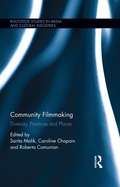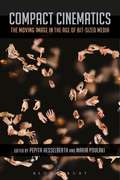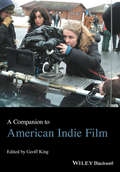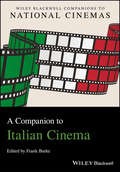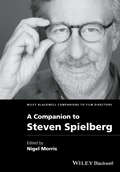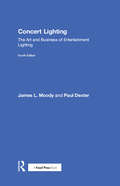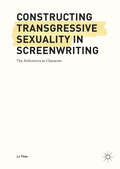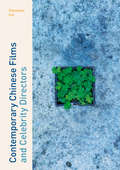- Table View
- List View
Community Filmmaking: Diversity, Practices and Places (Routledge Studies in Media and Cultural Industries)
This book examines the role of community filmmaking in society and its connection with issues of cultural diversity, innovation, policy and practice in various places. Deploying a range of examples from Europe, North America, Australia and Hong Kong, the chapters show that film emerging from outside the mainstream film industries and within community contexts can lead to innovation in terms of both content and processes and a better representation of the cultural diversity of a range of communities and places. The book aims to situate the community filmmaker as the central node in the complex network of relationships between diverse communities, funding bodies, policy and the film industries.
Compact Cinematics: The Moving Image in the Age of Bit-Sized Media
by Pepita Hesselberth Maria PoulakiCompact Cinematics challenges the dominant understanding of cinema to focus on the various compact, short, miniature, pocket-sized forms of cinematics that have existed from even before its standardization in theatrical form, and in recent years have multiplied and proliferated, taking up an increasingly important part of our everyday multimedia environment. Short films or micro-narratives, cinematic pieces or units re-assembled into image archives and looping themes, challenge the concepts that have traditionally been used to understand cinematic experience, like linear causality, sequentiality, and closure, and call attention to complex and modular forms of cinematic expression and perception. Such forms, in turn, seem to meet the requirements of digital convergence, which has pushed the development of more compact and mobile hardware for the display and use of audiovisual content on laptops, smartphones, and tablets. Meanwhile, contemporary economies of digital content acquisition, filing, and sharing equally require the shrinking of cinematic content for it to be recorded, played, projected, distributed, and installed with ease and speed. In this process, cinematic experience is shortened and condensed as well, so as to fit the late-capitalist attention economy. The essays in this volume ask what this changed technical, socio-economic and political situation entails for the aesthetics and experience of contemporary cinematics, and call attention to different concepts, theories and tools at our disposal to analyze these changes.
Compact Cinematics: The Moving Image in the Age of Bit-Sized Media
by Pepita Hesselberth Maria PoulakiCompact Cinematics challenges the dominant understanding of cinema to focus on the various compact, short, miniature, pocket-sized forms of cinematics that have existed from even before its standardization in theatrical form, and in recent years have multiplied and proliferated, taking up an increasingly important part of our everyday multimedia environment. Short films or micro-narratives, cinematic pieces or units re-assembled into image archives and looping themes, challenge the concepts that have traditionally been used to understand cinematic experience, like linear causality, sequentiality, and closure, and call attention to complex and modular forms of cinematic expression and perception. Such forms, in turn, seem to meet the requirements of digital convergence, which has pushed the development of more compact and mobile hardware for the display and use of audiovisual content on laptops, smartphones, and tablets. Meanwhile, contemporary economies of digital content acquisition, filing, and sharing equally require the shrinking of cinematic content for it to be recorded, played, projected, distributed, and installed with ease and speed. In this process, cinematic experience is shortened and condensed as well, so as to fit the late-capitalist attention economy. The essays in this volume ask what this changed technical, socio-economic and political situation entails for the aesthetics and experience of contemporary cinematics, and call attention to different concepts, theories and tools at our disposal to analyze these changes.
A Companion to American Indie Film (Wiley Blackwell Companions to Film Directors)
by Geoff KingA Companion to American Indie Film features a comprehensive collection of newly commissioned essays that represent a state-of-the-art resource for understanding key aspects of the field of indie films produced in the United States. Takes a comprehensive and fresh new look at the topic of American indie film Features newly commissioned essays from top film experts and emerging scholars that represent the state-of-the-art reference to the indie film field Topics covered include: indie film culture; key historical moments and movements in indie film history; relationships between indie film and other indie media; and issues including class, gender, regional identity and stardom in in the indie field Includes studies of many types of indie films and film genres, along with various filmmakers and performers that have come to define the field
A Companion to American Indie Film (Wiley Blackwell Companions to Film Directors)
by Geoff KingA Companion to American Indie Film features a comprehensive collection of newly commissioned essays that represent a state-of-the-art resource for understanding key aspects of the field of indie films produced in the United States. Takes a comprehensive and fresh new look at the topic of American indie film Features newly commissioned essays from top film experts and emerging scholars that represent the state-of-the-art reference to the indie film field Topics covered include: indie film culture; key historical moments and movements in indie film history; relationships between indie film and other indie media; and issues including class, gender, regional identity and stardom in in the indie field Includes studies of many types of indie films and film genres, along with various filmmakers and performers that have come to define the field
A Companion to Italian Cinema (Wiley Blackwell Companions to National Cinemas)
by Frank BurkeWritten by leading figures in the field, A Companion to Italian Cinema re-maps Italian cinema studies, employing new perspectives on traditional issues, and fresh theoretical approaches to the exciting history and field of Italian cinema. Offers new approaches to Italian cinema, whose importance in the post-war period was unrivalled Presents a theory based approach to historical and archival material Includes work by both established and more recent scholars, with new takes on traditional critical issues, and new theoretical approaches to the exciting history and field of Italian cinema Covers recent issues such as feminism, stardom, queer cinema, immigration and postcolonialism, self-reflexivity and postmodernism, popular genre cinema, and digitalization A comprehensive collection of essays addressing the prominent films, directors and cinematic forms of Italian cinema, which will become a standard resource for academic and non-academic purposes alike
A Companion to Italian Cinema (Wiley Blackwell Companions to National Cinemas)
by Frank BurkeWritten by leading figures in the field, A Companion to Italian Cinema re-maps Italian cinema studies, employing new perspectives on traditional issues, and fresh theoretical approaches to the exciting history and field of Italian cinema. Offers new approaches to Italian cinema, whose importance in the post-war period was unrivalled Presents a theory based approach to historical and archival material Includes work by both established and more recent scholars, with new takes on traditional critical issues, and new theoretical approaches to the exciting history and field of Italian cinema Covers recent issues such as feminism, stardom, queer cinema, immigration and postcolonialism, self-reflexivity and postmodernism, popular genre cinema, and digitalization A comprehensive collection of essays addressing the prominent films, directors and cinematic forms of Italian cinema, which will become a standard resource for academic and non-academic purposes alike
A Companion to Steven Spielberg (Wiley Blackwell Companions to Film Directors)
by Nigel MorrisA Companion to Steven Spielberg provides an authoritative collection of essays exploring the achievements and legacy of one of the most influential film directors of the modern era. Offers comprehensive coverage of Spielberg’s directorial output, from early works including Duel, The Sugarland Express, and Jaws, to recent films Explores Spielberg’s contribution to the development of visual effects and computer games, as well as the critical and popular reception of his films Topics include in-depth analyses of Spielberg’s themes, style, and filming techniques; commercial and cultural significance of the Spielberg ‘brand’ and his parallel career as a producer; and collaborative projects with artists and composers Brings together an international team of renowned scholars and emergent voices, balancing multiple perspectives and critical approaches Creates a timely and illuminating resource which acknowledges the ambiguity and complexity of Spielberg’s work, and reflects its increasing importance to film scholarship
A Companion to Steven Spielberg (Wiley Blackwell Companions to Film Directors)
by Nigel MorrisA Companion to Steven Spielberg provides an authoritative collection of essays exploring the achievements and legacy of one of the most influential film directors of the modern era. Offers comprehensive coverage of Spielberg’s directorial output, from early works including Duel, The Sugarland Express, and Jaws, to recent films Explores Spielberg’s contribution to the development of visual effects and computer games, as well as the critical and popular reception of his films Topics include in-depth analyses of Spielberg’s themes, style, and filming techniques; commercial and cultural significance of the Spielberg ‘brand’ and his parallel career as a producer; and collaborative projects with artists and composers Brings together an international team of renowned scholars and emergent voices, balancing multiple perspectives and critical approaches Creates a timely and illuminating resource which acknowledges the ambiguity and complexity of Spielberg’s work, and reflects its increasing importance to film scholarship
A Companion to the History of American Broadcasting (Blackwell Companions in Cultural Studies)
by Aniko BodroghkozyPresented in a single volume, this engaging review reflects on the scholarship and the historical development of American broadcasting A Companion to the History of American Broadcasting comprehensively evaluates the vibrant history of American radio and television and reveals broadcasting’s influence on American history in the twentieth and twenty-first centuries. With contributions from leading scholars on the topic, this wide-ranging anthology explores the impact of broadcasting on American culture, politics, and society from an historical perspective as well as the effect on our economic and social structures. The text’s original and accessibly-written essays offer explorations on a wealth of topics including the production of broadcast media, the evolution of various television and radio genres, the development of the broadcast ratings system, the rise of Spanish language broadcasting in the United States, broadcast activism, African Americans and broadcasting, 1950’s television, and much more. This essential resource: Presents a scholarly overview of the history of radio and television broadcasting and its influence on contemporary American history Contains original essays from leading academics in the field Examines the role of radio in the television era Discusses the evolution of regulations in radio and television Offers insight into the cultural influence of radio and television Analyzes canonical texts that helped shape the field Written for students and scholars of media studies and twentieth-century history, A Companion to the History of American Broadcasting is an essential and field-defining guide to the history and historiography of American broadcasting and its many cultural, societal, and political impacts.
A Companion to the History of American Broadcasting (Blackwell Companions in Cultural Studies)
by Aniko BodroghkozyPresented in a single volume, this engaging review reflects on the scholarship and the historical development of American broadcasting A Companion to the History of American Broadcasting comprehensively evaluates the vibrant history of American radio and television and reveals broadcasting’s influence on American history in the twentieth and twenty-first centuries. With contributions from leading scholars on the topic, this wide-ranging anthology explores the impact of broadcasting on American culture, politics, and society from an historical perspective as well as the effect on our economic and social structures. The text’s original and accessibly-written essays offer explorations on a wealth of topics including the production of broadcast media, the evolution of various television and radio genres, the development of the broadcast ratings system, the rise of Spanish language broadcasting in the United States, broadcast activism, African Americans and broadcasting, 1950’s television, and much more. This essential resource: Presents a scholarly overview of the history of radio and television broadcasting and its influence on contemporary American history Contains original essays from leading academics in the field Examines the role of radio in the television era Discusses the evolution of regulations in radio and television Offers insight into the cultural influence of radio and television Analyzes canonical texts that helped shape the field Written for students and scholars of media studies and twentieth-century history, A Companion to the History of American Broadcasting is an essential and field-defining guide to the history and historiography of American broadcasting and its many cultural, societal, and political impacts.
The Company of Wolves (Devil's Advocates)
by James GraceyCo-written by Irish filmmaker Neil Jordan and British novelist Angela Carter, and based on several short stories from Carter's collection The Bloody Chamber, The Company of Wolves (1984) is a provocative reinvention of the fairy tale of Little Red Riding Hood. Unraveling a feverish metaphor for the blossoming of a young girl's sexuality and her subsequent loss of innocence, the film entwines symbolism and metaphor with striking visuals and grisly effects. Released in the early 1980s, a time which produced several classic werewolf films (including An American Werewolf in London and The Howling), The Company of Wolves sets itself apart from the pack with its overtly literary roots, feminist stance, and art-house leanings. The film's narrative takes the form of a puzzle box, unfolding as dreams within dreams, and stories within stories, which lead further into the dark woods of the protagonist's psyche, as she finds herself on the cusp of womanhood. This Devil's Advocate explores all these aspects, as well as placing the film in the context of the careers of its creators and its position as an example of the "Female Gothic."
The Complete Guide to Film and Digital Production: The People and The Process
by Lorene M. WalesThis expanded, updated, and revised third edition of Lorene Wales’ The Complete Guide to Film and Digital Production offers a comprehensive introduction to the positions/roles, procedures, and logistics of the film and digital video production process, from development and pre-production all the way to marketing and distribution. Lorene Wales offers a hands-on approach suitable for projects of any budget and scale, explaining every stage and key role/position in the life of a film and providing a wealth of sample checklists, schedules, accounting paperwork, and downloadable forms and templates for practical use. Other topics include a description of the latest mobile apps used in production, tax incentives, the DIT, set safety, and an expanded chapter on copyright, fair use and other legal matters. A companion website includes video tutorials, a personnel hierarchy, a guide to mobile apps useful during production, PowerPoints for instructor use, and a complete set of sample production forms and templates for download, including schedules, accounting paperwork, releases, and production checklists.
The Complete Guide to Film and Digital Production: The People and The Process
by Lorene M. WalesThis expanded, updated, and revised third edition of Lorene Wales’ The Complete Guide to Film and Digital Production offers a comprehensive introduction to the positions/roles, procedures, and logistics of the film and digital video production process, from development and pre-production all the way to marketing and distribution. Lorene Wales offers a hands-on approach suitable for projects of any budget and scale, explaining every stage and key role/position in the life of a film and providing a wealth of sample checklists, schedules, accounting paperwork, and downloadable forms and templates for practical use. Other topics include a description of the latest mobile apps used in production, tax incentives, the DIT, set safety, and an expanded chapter on copyright, fair use and other legal matters. A companion website includes video tutorials, a personnel hierarchy, a guide to mobile apps useful during production, PowerPoints for instructor use, and a complete set of sample production forms and templates for download, including schedules, accounting paperwork, releases, and production checklists.
Concert Lighting: The Art and Business of Entertainment Lighting
by James Moody Paul DexterConcert Lighting: Tools, Techniques, Art, and Business Fourth Edition provides readers with an updated look at how to succeed in the complex world of concert lighting design and technology. The authors have reorganized the book into three comprehensive and thoroughly revised sections, covering history, equipment and technology, and design, and containing new information on LED technology, pixel mapping, projection options, media servers, automated lighting, solutions for moving lights, DMX, and Ethernet problems, and designer communication and collaboration. This book also explores the cross-media use of concert lighting techniques in film, video, theatre, and the corporate world, highlighted with advice from master designers such as Bruce Rodgers, Cosmo Wilson, and Sarah Landau. From securing precious contracts to knowing the best equipment to use to design a show, Concert Lighting covers everything a designer needs to know about working in the touring industry.
Concert Lighting: The Art and Business of Entertainment Lighting
by James Moody Paul DexterConcert Lighting: Tools, Techniques, Art, and Business Fourth Edition provides readers with an updated look at how to succeed in the complex world of concert lighting design and technology. The authors have reorganized the book into three comprehensive and thoroughly revised sections, covering history, equipment and technology, and design, and containing new information on LED technology, pixel mapping, projection options, media servers, automated lighting, solutions for moving lights, DMX, and Ethernet problems, and designer communication and collaboration. This book also explores the cross-media use of concert lighting techniques in film, video, theatre, and the corporate world, highlighted with advice from master designers such as Bruce Rodgers, Cosmo Wilson, and Sarah Landau. From securing precious contracts to knowing the best equipment to use to design a show, Concert Lighting covers everything a designer needs to know about working in the touring industry.
Constructing Transgressive Sexuality in Screenwriting: The Feiticeiro/a as Character
by Lj TheoThis book approaches the construction of complex and transgressive ‘pervert’ characters in mainstream (not ‘art’), adult-oriented (not pornographic) cinema. It deconstructs an episteme on which to base the construction of characters in screenplays, in a way that acknowledges how semiotic elements of characterisation intersect. In addition, it provides an extended re-phrasing of the notion of ‘the pervert’ as Feiticiero/a: a newly-coined construct that might serve as an underpinning for complex, sexual filmic characters that are both entertaining and challenging to audiences. This re-phrasing speaks to both an existential/phenomenological conception of personhood and to the scholarly tradition of the ‘linguistic turn’ of continental philosophers such as Foucault and Lacan, who represent language not primarily as describing the world but as constructing it. The result is an original and interdisciplinary volume that is brought to coherence through a queer, post-humanist lens.
Constructing Transgressive Sexuality in Screenwriting: The Feiticeiro/a as Character
by Lj TheoThis book approaches the construction of complex and transgressive ‘pervert’ characters in mainstream (not ‘art’), adult-oriented (not pornographic) cinema. It deconstructs an episteme on which to base the construction of characters in screenplays, in a way that acknowledges how semiotic elements of characterisation intersect. In addition, it provides an extended re-phrasing of the notion of ‘the pervert’ as Feiticiero/a: a newly-coined construct that might serve as an underpinning for complex, sexual filmic characters that are both entertaining and challenging to audiences. This re-phrasing speaks to both an existential/phenomenological conception of personhood and to the scholarly tradition of the ‘linguistic turn’ of continental philosophers such as Foucault and Lacan, who represent language not primarily as describing the world but as constructing it. The result is an original and interdisciplinary volume that is brought to coherence through a queer, post-humanist lens.
Consuming Gothic: Food and Horror in Film (Palgrave Gothic)
by Lorna Piatti-FarnellThis book offers a critical analysis of the relationship between food and horror in post-1980 cinema. Evaluating the place of consumption within cinematic structures, Piatti-Farnell analyses how seemingly ordinary foods are re-evaluated in the Gothic framework of irrationality and desire. The complicated and often ambiguous relationship between food and horror draws important and inescapable connections to matters of disgust, hunger, abjection, violence, as well as the sensationalisation of transgressive corporeality and monstrous pleasures. By looking at food consumption within Gothic cinema, the book uncovers eating as a metaphorical activity of the self, where the haunting psychology of the everyday, the porous boundaries of the body, and the uncanny limits of consumer identity collide. Aimed at scholars, researchers, and students of the field, Consuming Gothic charts different manifestations of food and horror in film while identifying specific socio-political and cultural anxieties of contemporary life.
Contemporary British Horror Cinema: Industry, Genre and Society
by Johnny WalkerCombining industrial research and primary interview material with detailed textual analysis, Contemporary British Horror Cinema looks beyond the dominant paradigms which have explained away British horror in the past, and sheds light on one of the most dynamic and distinctive †“ yet scarcely talked about †“ areas of contemporary British film production. Considering high-profile theatrical releases, including The Descent, Shaun of the Dead and The Woman in Black, as well as more obscure films such as The Devil’s Chair, Resurrecting the Street Walker and Cherry Tree Lane, Contemporary British Horror Cinema provides a thorough examination of British horror film production in the twenty-first century.
Contemporary British Television Crime Drama: Cops on the Box (Routledge Advances in Television Studies)
by Ruth McElroyContemporary British Television Crime Drama examines one of the medium’s most popular genres and places it within its historical and industrial context. The television crime drama has proved itself capable of numerous generic reinventions and continues to enjoy some of the highest viewing figures. Crime drama offers audiences stories of right and wrong, moral authority asserted and resisted, and professionals and criminals, doing so in ways that are often highly entertaining, innovative, and thought provoking. In examining the appeal of this highly dynamic genre, this volume explores how it responds not only to changing social debates on crime and policing, but also to processes of hybridization within the television industry itself. Contributors, many of whom are leading figures in UK television studies, analyse popular series such as Broadchurch, Between the Lines, Foyle’s War, Poirot, Prime Suspect, Sherlock and Wallander. Essays examine the main characteristics of television crime drama production, including the nature of trans-Atlantic franchises and literary and transnational adaptations. Adopting a range of feminist, historical, aesthetic and industrial approaches, they offer incisive interrogations that provide readers with a rich understanding of the allure of crime drama to both viewers and commissioners.
Contemporary British Television Crime Drama: Cops on the Box (Routledge Advances in Television Studies)
by Ruth McElroyContemporary British Television Crime Drama examines one of the medium’s most popular genres and places it within its historical and industrial context. The television crime drama has proved itself capable of numerous generic reinventions and continues to enjoy some of the highest viewing figures. Crime drama offers audiences stories of right and wrong, moral authority asserted and resisted, and professionals and criminals, doing so in ways that are often highly entertaining, innovative, and thought provoking. In examining the appeal of this highly dynamic genre, this volume explores how it responds not only to changing social debates on crime and policing, but also to processes of hybridization within the television industry itself. Contributors, many of whom are leading figures in UK television studies, analyse popular series such as Broadchurch, Between the Lines, Foyle’s War, Poirot, Prime Suspect, Sherlock and Wallander. Essays examine the main characteristics of television crime drama production, including the nature of trans-Atlantic franchises and literary and transnational adaptations. Adopting a range of feminist, historical, aesthetic and industrial approaches, they offer incisive interrogations that provide readers with a rich understanding of the allure of crime drama to both viewers and commissioners.
Contemporary Chinese Films and Celebrity Directors
by Shenshen CaiThis new text examines recent popular Chinese films and derivative cultural phenomena, with a focus on films directed by celebrity directors such as Han Han, Guo Jingming, Xu Jinglei and Zhao Wei. In opposition to Fifth and Sixth Generation Chinese filmmakers who explored the grand-narratives of history, the oppression of the pre-socialist and socialist eras, and those marginalized by socio-economic changes, the celebrity directors at the heart of this book center on the new trends of living and emotional challenges faced by contemporary Chinese people, in particular the younger generations. This book sheds light on newly emerging social and cultural fashions in contemporary China, such as the social stigma of being ‘left-over’ (reflected in Xu Jinglei’s films), the issue of wealth ‘flaunting’ (represented in Guo Jingming’s films) or nostalgia for the long lost innocence of adolescence (demonstrated in Zhao Wei’s film). Considering present-day consumer capitalism through the lens of cinema, this text analyses in detail the significance of films chosen for their relevance, providing a reflection of social reality and cultural changes in 21st century China.
Contemporary Chinese Films and Celebrity Directors
by Shenshen CaiThis new text examines recent popular Chinese films and derivative cultural phenomena, with a focus on films directed by celebrity directors such as Han Han, Guo Jingming, Xu Jinglei and Zhao Wei. In opposition to Fifth and Sixth Generation Chinese filmmakers who explored the grand-narratives of history, the oppression of the pre-socialist and socialist eras, and those marginalized by socio-economic changes, the celebrity directors at the heart of this book center on the new trends of living and emotional challenges faced by contemporary Chinese people, in particular the younger generations. This book sheds light on newly emerging social and cultural fashions in contemporary China, such as the social stigma of being ‘left-over’ (reflected in Xu Jinglei’s films), the issue of wealth ‘flaunting’ (represented in Guo Jingming’s films) or nostalgia for the long lost innocence of adolescence (demonstrated in Zhao Wei’s film). Considering present-day consumer capitalism through the lens of cinema, this text analyses in detail the significance of films chosen for their relevance, providing a reflection of social reality and cultural changes in 21st century China.
Contemporary Cinema and 'Old Age': Gender and the Silvering of Stardom
by Josephine DolanThis book is the first to explore ‘old age’ in cinema at the intersection of gender, ageing, celebrity and genre studies. It takes its cue from the dual meanings of ‘silvering’ – economics and ageing – and explores shifting formulations of ‘old age’ and gender in contemporary cinema. Broad in its scope, the book establishes the importance of silver audiences to the survival of cinema exhibition while also forging connections between the pleasures of ‘old age’ films, consumer culture, the ‘economy of celebrity’ and the gendered silvering of stardom. The chapters examine gendered genres such as romantic comedies, action and heist movies, the prosthetics of costume, and CGI enabled age transformations. Through this analysis, Josephine Dolan teases out the different meanings of ageing masculinity and femininity offered in contemporary cinema. She identifies ageing femininity as the pathologised target of rejuvenation while masculine ageing is seen to enhance an enduring youthfulness. This book has interdisciplinary appeal and will engage scholars interested in ‘old age’ and gender representations in contemporary cinema.
